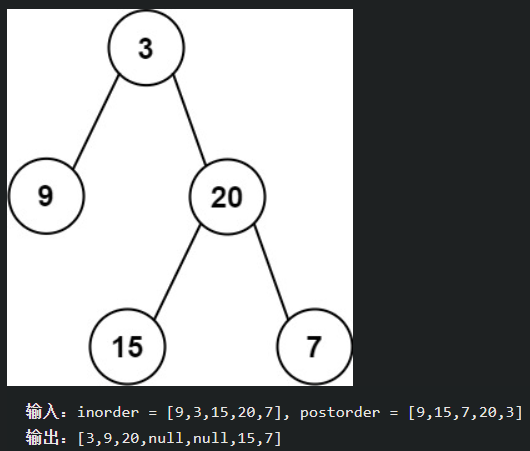从中序和后序遍历序列构造二叉树
LeetCode106. 从中序与后序遍历序列构造二叉树
给定两个整数数组inorder和postorder,其中inorder是二叉树的中序遍历,postorder是同一棵树的后序遍历,请你构造并返回这颗二叉树

思路
根据两个顺序构造一个唯一的二叉树:以后序数组的最后一个元素为切割点,先切中序数组,根据中序数组,反过来再切后序数组。一层一层切下去,每次后序数组最后一个元素就是节点元素
说到一层一层切割,就应该想到了递归。来看一下一共分几步:
- 第一步:如果数组大小为零的话,说明是空节点了。
- 第二步:如果不为空,那么取后序数组最后一个元素作为节点元素。
- 第三步:找到后序数组最后一个元素在中序数组的位置,作为切割点
- 第四步:切割中序数组,切成中序左数组和中序右数组 (顺序别搞反了,一定是先切中序数组)
- 第五步:切割后序数组,切成后序左数组和后序右数组
- 第六步:递归处理左区间和右区间
注意:前序和后序不能唯一确定一棵二叉树!,因为没有中序遍历无法确定左右部分,也就是无法分割
代码
Go
1
2
3
4
5
6
7
8
9
10
11
12
13
14
15
16
17
18
19
20
21
22
23
24
25
26
|
func buildTree(inorder []int, postorder []int) *TreeNode {
//若为空数组,则返回nil
if len(inorder) < 1 || len(postorder) < 1 {
return nil
}
//先找到根节点(后续遍历的最后一个就是根节点),保存节点值到nodeValue
nodeValue := postorder[len(postorder)-1]
//从中序遍历中找到一分为二的点,左边为左子树,右边为右子树
midIndex := findRootIndex(inorder, nodeValue)
//构造root
root := &TreeNode{Val: nodeValue,
//将后续遍历一分为二,左边为左子树,右边为右子树
Left: buildTree(inorder[:midIndex], postorder[:midIndex]),
Right: buildTree(inorder[midIndex+1:], postorder[midIndex:len(postorder)-1])}
return root
}
//从中序数组中找到中间节点的索引
func findRootIndex(inorder []int, target int) (index int) {
for i := 0; i < len(inorder); i++ {
if target == inorder[i] {
return i
}
}
return -1
}
|
Link
GitHub
